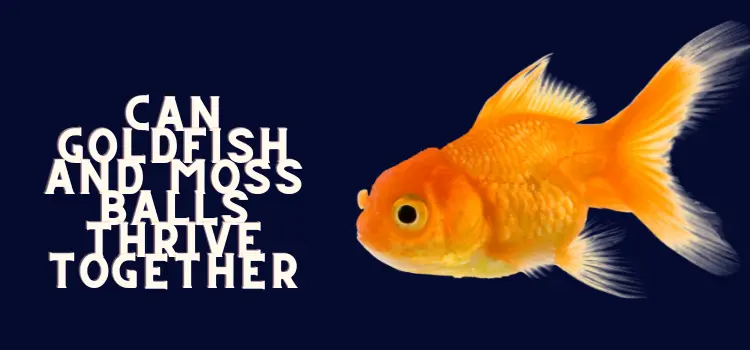Goldfish are one of the most popular and beloved freshwater fish kept as pets. Their vibrant colors and playful nature make them a joy to watch.
On the other hand, moss balls are unique and captivating aquatic plants that add a touch of natural beauty to any aquarium. But can these two coexist in harmony within the same tank?
The Aquatic Duo: Goldfish and Moss Balls
Goldfish (Carassius auratus) and moss balls (Aegagropila linnaei) can thrive under the right conditions. The pairing of these two creates a visually appealing and biologically beneficial setup for your aquarium.
Benefits of Keeping Goldfish and Moss Balls Together
Natural Aquatic Symbiosis
Moss balls and Goldfish create a symbiotic relationship. The moss balls provide a source of food and shelter for the Goldfish. In return, the Goldfish produce waste, a natural fertilizer for the moss balls.
This mutually beneficial interaction helps maintain a balanced and healthy ecosystem in the aquarium.
Improved Water Quality
Moss balls can remarkably absorb and trap various impurities from the water, such as nitrates and phosphates. These substances are harmful to fish when present in excess.
Stress Reduction
The presence of moss balls can have a calming effect on Goldfish. They provide a place for the fish to rest and hide, which reduces stress levels. Lower stress levels promote better health and longevity in Goldfish.
Setting Up the Perfect Environment
Creating a suitable environment for both is essential to ensure the successful cohabitation of goldfish and moss balls.
Aquarium Size and Type
Goldfish are active swimmers and produce more waste than other fish. Therefore, a spacious aquarium with a minimum capacity of 20 gallons is recommended. The shape of the tank should be rectangular to provide ample swimming space for the Goldfish.
Water Conditions
Goldfish prefer slightly alkaline water with a pH range between 7.2 and 7.6. Moss balls thrive in a similar pH range. Maintain a consistent water temperature between 68°F and 74°F (20°C to 23°C) for both species.
Tank Decorations
Incorporate various hiding spots and aquarium decorations to create a stimulating and aesthetically pleasing environment. Ensure that the moss balls are securely anchored to prevent them from being dislodged by curious Goldfish.
Choosing Moss Balls
When selecting moss balls, opt for healthy and vibrant green ones. Avoid moss balls with brown spots or foul odors, which indicate poor health.
Selecting Goldfish
Choose Goldfish that are compatible with each other and similar in size. Avoid mixing species that may exhibit aggressive behavior towards one another.
Feeding Your Aquatic Friends
Goldfish are omnivores and have hearty appetites. Provide a balanced diet with high-quality flakes, pellets, and occasional treats like frozen or live foods.
Moss balls derive nutrients from the water and can absorb some organic matter, but they are not a primary food source for Goldfish.
Maintenance and Care
Proper maintenance is crucial to ensure the well-being of both goldfish and moss balls.
Cleaning the Tank
Regularly clean the aquarium by removing debris and performing partial water changes. Gently roll the moss balls in your hands during water changes to prevent uneven growth.
Monitoring Water Parameters
Regularly test the water parameters using a reliable test kit. Keep a close eye on ammonia, nitrite, and nitrate levels to ensure a healthy environment for your aquatic friends.
Handling Moss Balls
Handle moss balls with care to avoid damaging their delicate structure. Rinse them gently under running water during water changes.
Goldfish Care
Observe your Goldfish for any signs of illness or abnormal behavior.
Common Challenges and Solutions
Despite the benefits of keeping goldfish and moss balls together, certain challenges may arise.
Algae Growth
If the tank receives excessive sunlight or has high nutrient levels, algae may increase. Combat this by reducing light exposure and performing regular water changes.
Overfeeding
Overfeeding can lead to water quality issues and health problems for Goldfish. Feed them sparingly and remove any uneaten food promptly.
Goldfish Aggression
In some cases, Goldfish may display aggressive behavior towards one another. If aggression is observed, consider providing additional hiding spots to diffuse tension.
Moss Ball Disintegration
Moss balls can disintegrate over time. If you notice this, gently remove the disintegrating portions to maintain water quality.
Conclusion
In conclusion, Goldfish and moss balls can thrive in a harmonious aquatic environment. Their symbiotic relationship offers mutual benefits, including improved water quality and stress reduction for Goldfish.
You can enjoy a captivating and healthy aquarium with this delightful aquatic duo by providing the right conditions and care.
FAQs
What are the benefits of keeping goldfish and moss balls together in the same aquarium?
Keeping goldfish and moss balls together can be an enriching experience for both species. Goldfish may occasionally try to nibble on the moss balls, but this can be prevented by providing them with plenty of food or supplementing their diet with nutrient-rich aquatic plants.
How do goldfish and moss balls enhance each other’s living environment?
The tank should be cleaned at least once weekly to maintain water quality and remove waste. Some types of goldfish may not be compatible with certain species of moss balls because they may become aggressive towards or eat the plants. Using live plants, including moss balls, Signs that indicate your goldfish or moss ball may not be thriving in their shared environment could include:
Changes in coloration.
Lack of appetite.
Darting around the tank erratically.
Signs of disease such as white spots on their bodies.
Are there any specific care requirements for maintaining a healthy habitat for goldfish and moss balls?
Regarding compatibility, certain types of goldfish, such as common fancy goldfish, should not be kept with larger species of moss balls due to their slow swimming speed and poor maneuverability. Lastly, suppose you notice rapid breathing or gill movements from your goldfish or signs of discoloration in the moss ball. In that case, it’s likely that one or both are struggling in their shared environment and may need additional attention or a bigger tank size.
